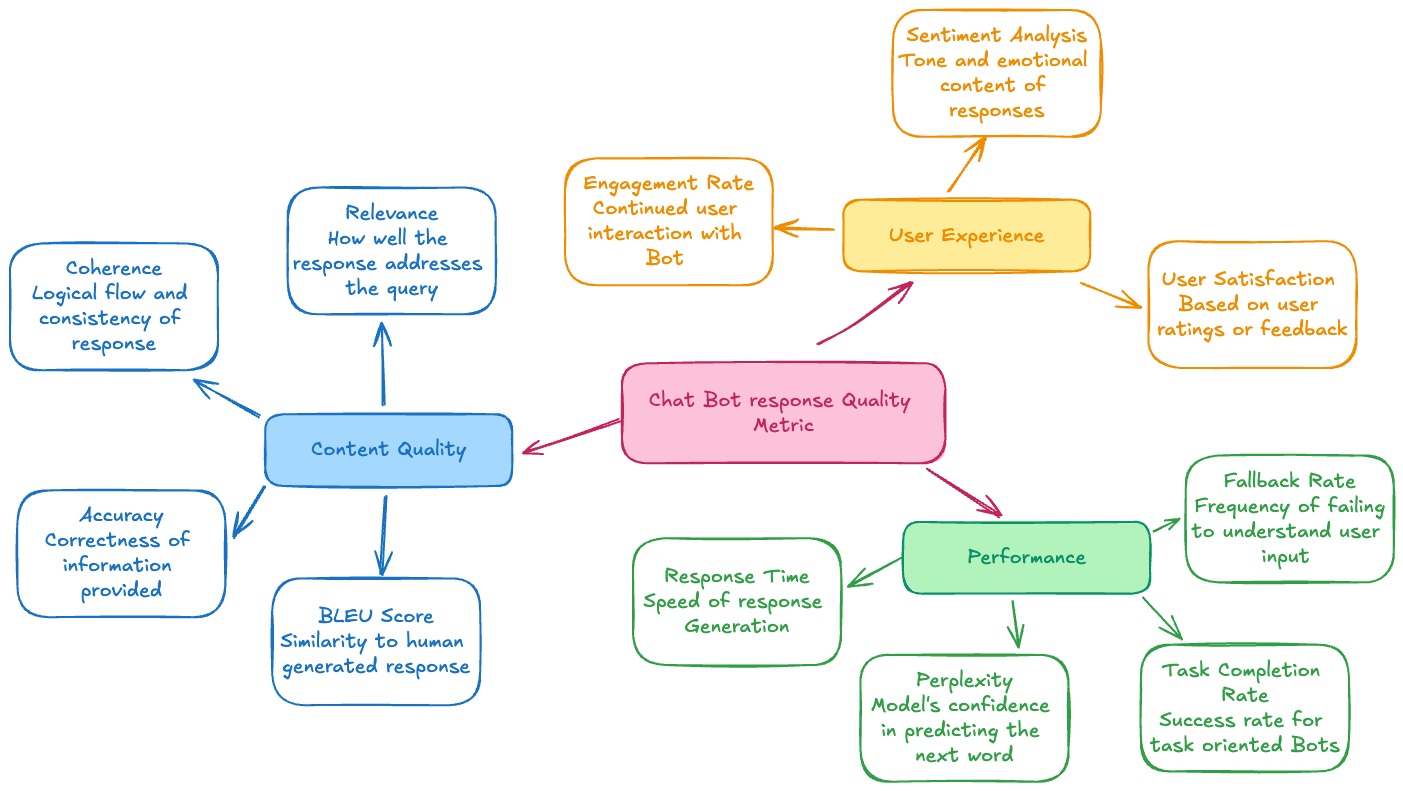Chatbot Quality Metrics
Published:
Quick overview of Chatbot Quality Metrics and Improving Chatbot Quality
Metrics
There are a few metrics that are commonly used to evaluate the quality of a chatbot

These are broadly classified into three categories:
- Content Quality
- Relevance: Measures how well the chatbot response addresses the user query
- Coherence: Asseses the logical flow and consistency of the response
- Accuracy: Evaluates the correctness of the information provided in the response
- BLUE Score: Measures the similarity between the generated response and human reference
- Performance
- Response Time: Measures the time taken by the chatbot to respond to a user query
- Perplexity: Measures the uncertainty of the chatbot’s response, need to be minimized. That is, the lower the perplexity, the better the model.
- Task Completion Rate: For task oriented bots, this measures how often users sucessfully complete their intended tasks
- Fall Back Rate: The frequency at which the chatbot fails to provide a satisfactory response and needs to fallback to a human in the loop
User Experience
- User Satisfaction: Measured through user ratings and feedback
- Sentiment Analysis: Analyses the sentiment and tone of the chatbot responses
- Engagement Rate: Measures how often users interact with the chatbot
How to Improve Chatbot Quality
There are several ways to improve the quality of a chatbot. Here are a few suggestions:
- Content Quality Improvements
- Data Enhancement
- Expand and diversify the training datasets
- Augment with high quality data
- Model Refinement
- Experiment with Different model architectures. eg, Mamba (SSM based model), RAG etc..
- Fine-tune on domain specific data
- Contextual Understanding
- Implement context retention mechanisms. e.g. KVCache, Prefill phase
- Use conversational memory to maintain context across turns
- Response Generation
- Use advanced response generation techniques like beam search, nucleus sampling, top-k sampling
- Implement response reranking to select the best response from a set of generated responses. techniques like BLEU score, perplexity can be used for reranking
- Experiment different RAG techniques for response generation
- Data Enhancement
- Performance Improvements
- Optimization:
- Optimize the model for faster inference e.g. quantization, pruning, distillation
- Use caching mechanisms to store and retrieve frequently used data
- Optimize Kernels for faster computation. eg, Cuda , triton etc…
- If using a Transformer based model. Use Fast and memory efficient attention mechanisms like flash attention, flash decoding etc…
- Optimization:
- User Experience Improvements
- Personalization
- user profiling for tailored responses
- Develop memory mechanisms for conversational context retention
- Interaction design
- Implement a user friendly interface
- Use rich media elements like images, videos, gifs etc…
- Feeback loop
- user feedback collections mechanisms
- active learning for model improvement
- Personalization
- Overall Quality Enhancements
- Prompt Engineering
- Use self improving techniques and frameworks like DsPy etc..
- Experiment few shot learning
- Mechanisms where the prompt should not be changed with different models
- Safety and Ethics
- implement content moderation and safety mechanisms
- develop bias mitigation strategies (Honestly, this is a difficult problem to solve)
- Multimodal integrations
- incorporate multiple data types(text, images etc…)
- Cost Optimization
- Optimize the model for cost efficiency
- Use serverless architecture for cost optimization
- Use efficient data storage and retrieval mechanisms
- Continuous Improvement
- Regular model updates
- Monitor and analyze user feedback
- Prompt Engineering
